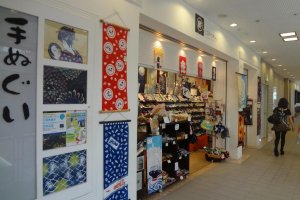Now that you’ve finished the many enjoyable things you planned to do in Japan, you probably need to start packing all your belongings into your suitcase. But wait—Don’t forget the souvenirs! And there is one particular souvenir (from two wonderful Yokohama shops) that you should definitely bring back home with you. I hope that you will find some nice TENUGUI (手拭い) and wrap your excellent Japan memories in them!
Tenugui is usually translated as “hand towel” or “facecloth” in English. But in fact, there are many other ways to use it in Japanese daily life. For example, as dish towels in the kitchen, as a luncheon or table mats, for wrapping gifts, and as headbands or scarves in Japanese festivals (matsuri). But perhaps the most popular (and a favorite of foreign tourists) is as interior decoration!
Yokohama tenugui make the perfect souvenir: They are light, beautiful, traditional or modern, come in a variety of colors and designs, are foldable, and very inexpensive (from 840 yen)!
Edonoren (江戸のれん) is located on the 5th floor of the Landmark Tower Plaza (11:00 to 20:00). The shop itself is pretty small but they have a delightful assortment of originally designed tenugui that showcase “all things Yokohama”. These Yokohama-themed tenugui are sold only at this shop. For example, one that I really like of the Yokohama Bay Bridge (the symbol of Yokohama) is quite modern in its design. The shop also has other Japanese gifts. Seasonal tengui would look lovely on your living room wall, set as a tapestry or in a nice wooden frame.
Koiki (小粋)” is on the 4th floor of Queen’s East (11:00 to 20:00). This shop has a large variety of tenugui displayed in a wide, open-spaced area. From Japanese traditional styles to unique manga designs, as well as Halloween- and Christmas-themed tenugui are displayed and for sale. If you can’t decide which one to get, ask a friendly clerk to make a suggestion. They will be able to help you to choose the best tenugui for your situation.
And both shops will provide you with English explanation sheets if you ask. In addition, if you really like tenugui and want to know more about how to use them, you can find books about them on Amazon.
History
In the old days, cotton itself was very precious and expensive, and only noble class people could get it. In the Heian era (794-1185 AD) tenugui was mainly used for Shinto rituals. After the Edo Shogunate was established (1603-1868), the cultivation of cotton plants became more wide spread in Japan. Then ordinary people started to find uses for cotton in their lives. At first people brought tenugui for work, to wipe their face and body, wrap their head to protect it against the sun, and to tie their hair back. After using them for many years they became old and dirty, and were then used as dust cloths. Later, when Edo culture flourished and Kabuki became a popular entertainment among the people, Kabuki actors showed tenugui as their own symbols. A lot of Kabuki fans followed the actor’s fashion and bought tenugui. After that, various designs and colors of tenugui appeared in shops.
Even now we sometimes make team tenugui for sports events and local festivals. When we use the same tenugui as a group, it can make us feel that we are bound tightly to the same purpose, or show our team pride. When I was on the Kendo team in junior high school, we had our team tenugui with our mentor’s word “Shu-Ha-Ri.” It means that first we followed the mentor’s instruction, but then broke through the wall of our limits, seeking to grow and become independent from the mentor, at last.
Oh, by the way, Koiki (the shop in Queen’s Square East) can order-make tenugui with your name on it! Why don’t you get a personalized tenugui for your family or favorite group back home as a memento of your trip to Yokohama!


































